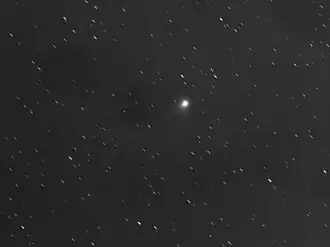C/1991 Y1 (Zanotta–Brewington)
 Comet Zanotta–Brewington photographed from the Heidelberg Observatory on 24 January 1992. | |
| Discovery[1] | |
|---|---|
| Discovered by | Mauro V. Zanotta Howard J. Brewington |
| Discovery site | Milan, Italy Cloudcroft, USA |
| Discovery date | 23–24 December 1991 |
| Designations | |
| 1992 III, 1991g1[2] | |
| Orbital characteristics[3][4] | |
| Epoch | 10 January 1992 (JD 2448631.5) |
| Observation arc | 130 days |
| Number of observations | 266 |
| Aphelion | ~1,790 AU (outbound) |
| Perihelion | 0.644 AU |
| Semi-major axis | ~900 AU (outbound) |
| Eccentricity | 1.00005 (inbound) 0.99929 (outbound) |
| Orbital period | ~26,800 years (outbound) |
| Inclination | 50.028° |
| 254.91° | |
| Argument of periapsis | 197.87° |
| Mean anomaly | –1.791° |
| Last perihelion | 31 January 1992 |
| Earth MOID | 0.319 AU |
| Jupiter MOID | 1.670 AU |
| Physical characteristics[5] | |
| Comet total magnitude (M1) | 10.2 |
| Comet nuclear magnitude (M2) | 17.0 |
| 7.3 (1992 apparition) | |
Comet Zanotta–Brewington, formally designated as C/1991 Y1, is a non-periodic comet that was observed telescopically between December 1991 and May 1992. It was discovered independently by both astronomers, Mauro V. Zanotta and Howard J. Brewington.
Physical characteristics
Photometric studies conducted at the La Silla Observatory revealed that the comet has a relatively high gas production rate (in comparison to 4P/Faye) at 110 x 1021 molec s-1/cm-1 during perihelion, which decreased with cyanogen activity by March 1992.[6]
Zanotta–Brewington's production rate ratio was compared to that of C/1991 X2 (Mueller) while both comets were around 0.64–0.72 AU (96–108 million km) from the Sun using CCD spectroscopy.[7] While their NH
2/H
2O ratios were identical, Zannota–Brewington's CN/H
2O ratio is found to be two times less than what was observed at Mueller.[7]
Orbit
In September 1993, Brian G. Marsden calculated an orbit that spans the comet's entire observation arc (130 days). He noted that the comet was weakly hyperbolic during its inbound trajectory,[8] indicating it was a dynamically new comet originating from the Oort cloud.[9] Gravitational perturbations of the giant planets has reduced the comet's relative velocity enough to attain a highly eccentric orbit that lasts for roughly 27,000 years during its outbound trajectory.[8]
See also
References
- ^ M. V. Zanotta; H. J. Brewington; D. H. Levy; T. Kojima; S. Nakano. B. G. Marsden (ed.). "Comet Zanotta–Brewington (1991g1)". IAU Circular. 5412 (1). Bibcode:1991IAUC.5412....1Z.
- ^ "Comet Names and Designations". International Comet Quarterly. Retrieved 9 July 2025.
- ^ "Barycentric Osculating Orbital Elements for Comet C/1991 Y1 (Zanotta–Brewington) in epoch 1800 and 2200". JPL Horizons On-Line Ephemeris System. Jet Propulsion Laboratory. Retrieved 9 July 2025. (Solution using the Solar System's barycenter (Sun+Jupiter). Select Ephemeris Type:Elements and Center:@0)
- ^ "C/1991 Y1 (Zanotta–Brewington) - JPL Small-Body Database Lookup". ssd.jpl.nasa.gov. Jet Propulsion Laboratory. Retrieved 9 July 2025.
- ^ G. W. Kronk; M. Meyer; D. A. J. Seargent (2017). Cometography: A Catalog of Comets. Vol. 6: 1983–1993. Cambridge University Press. pp. 637–641. ISBN 978-0-521-87216-4.
- ^ L. Jorda; O. Hainaut; A. Smette (1995). "Photometric study of comets 4P/Faye (1991 XXI) and Zanotta-Brewington (1992 III)". Planetary & Space Science. 43 (6): 737–745. Bibcode:1995P&SS...43..737J. doi:10.1016/0032-0633(94)E0047-T.
- ^ a b U. Finks; M. D. Hicks (1996). "A Survey of 39 Comets using CCD spectroscopy". The Astrophysical Journal. 459: 729–743. Bibcode:1996ApJ...459..729F. doi:10.1086/176938.
- ^ a b B. G. Marsden (1993). Catalogue of Cometary Orbits (8th ed.). p. 97. ASIN B0006P0NTM.
- ^ P. Pravec (9–12 July 1992). Surface brightness profiles of Two Comets: Long-term Time-resolved study. Meteoroids and their Parent Bodies: Proceedings of the International Astronomical Symposium. Smolenice, Slovakia. pp. 131–134. Bibcode:1993mtpb.conf..131P.
External links
- C/1991 Y1 at the JPL Small-Body Database

.png)